The ORPHEE tree species diversity experiment was established in south-western France in 2008 to investigate biodiversity and ecosystem functioning under the influence of a changing climate. The research focuses on the importance of leaf phenology, using 5 tree species of 2 functional groups (deciduous vs. evergreen).
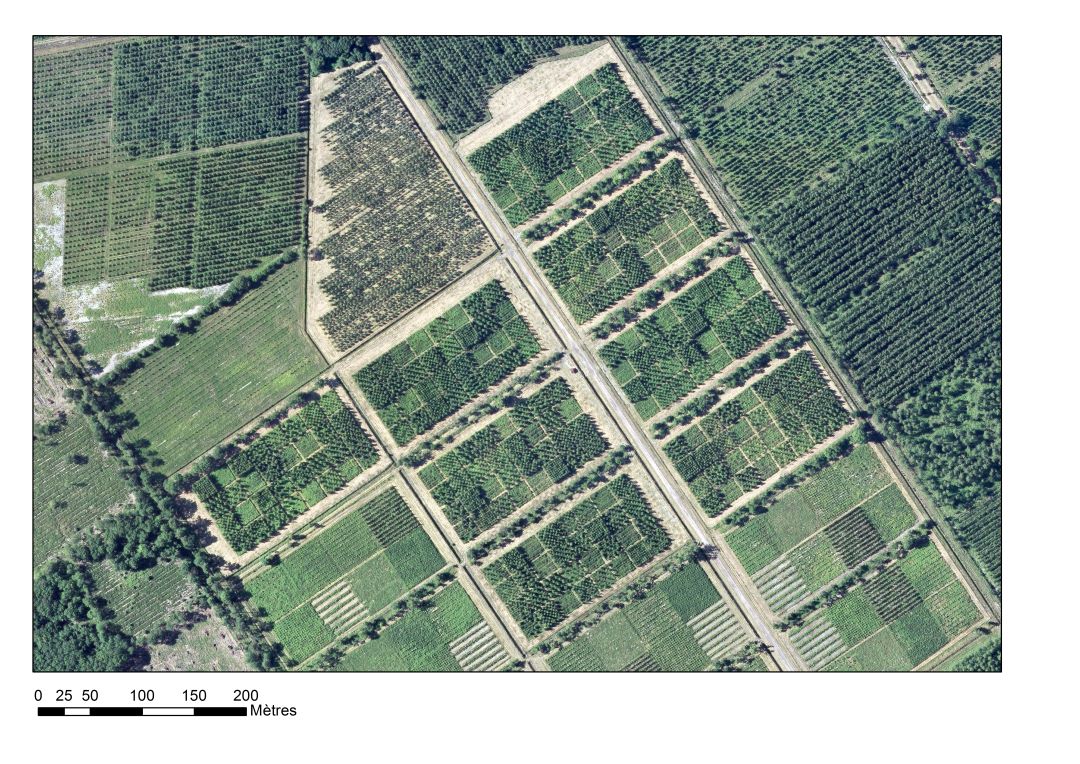 |
| Aerial view of the site in 2015 |
Design
The research site consists of 8 blocks, with 32 plots in each block. Every possible 1, 2, 3, 4 and 5-species combination was planted in each block; the last plot of a block was also planted with all 5 species. The plots are 20 m x 20 m large, and the planting distance between two trees was 2 m. Thus, 100 trees were planted per plot. The plots are randomly distributed in each block.
Half of the blocks will be irrigated to observe the changes in ecosystem functioning under a changing environment.
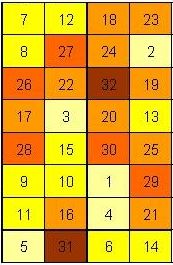 |
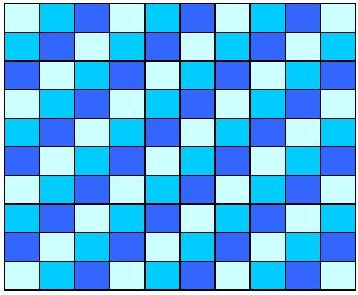 |
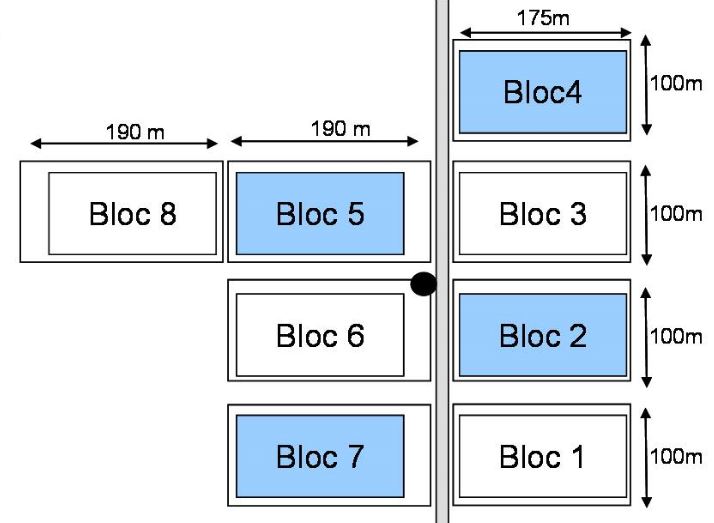 |
The plots within a block:
1 (light) - 5 (dark) species per plot |
Planting design in a 3-species plot |
Half of the blocks (in blue) will be irrigated. |
Site characteristics
| location |
Pierroton |
former land use |
pine stands (Pinus pinaster) |
| altitude |
60 m |
| soil type |
sandy podzol on sandstone bedrock |
| area |
ca. 12 ha |
| no of plots |
256 |
| plot size |
20 m x 20 m |
| no of trees planted |
25 600 |
| planting date |
January and February 2008 |
| diversity variables |
species richness
functional diversity |
| diversity gradient |
1, 2, 3, 4, 5 sp.
deciduous, evergreen |
| species pool |
deciduous: Betula pendula, Quercus pyrenaica, Quercus robur
evergreen: Quercus ilex, Pinus pinaster |
| contact person |
Hervé Jactel |
Research
The research will focus on the differences in tree growth and herbivory damage between the two leaf phenology groups and the irrigation treatment. Plant-plant interactions will be studied along the gradient of species richness and functional levels.
Extra information
Send an e-mail to the contact person, visit the experiment on facebook or the experiment's own website, or explore the publications:
- Bourdin A, Bord S, Durand J, Galon C, Moutailler S, Scherer-Lorenzen M, Jactel H (2022) Forest Diversity Reduces the Prevalence of Pathogens Transmitted by the Tick Ixodes Ricinus. Frontiers in Ecology and Evolution - https://doi.org/10.3389/fevo.2022.891908
- Cesarz S, Craven D, Auge H, Bruelheide H, Castagneyrol B, Gutknecht J, Hector A, Jactel H, Koricheva J, Messier C, Muys B, Brien MJO, Paquette A, Ponette Q, Potvin C, Reich PB, Scherer-Lorenzen M, Smith AR, Verheyen K, Eisenhauer N (2022) Tree diversity effects on soil microbial biomass and respiration are context dependent across forest diversity experiments. Global Ecology and Biogeography 31:872-885 - https://doi.org/10.1111/geb.13461
- Galmán A, Vázquez-González C, Röder G, Castagneyrol B (2022) Interactive effects of tree species composition and water availability on growth and direct and indirect defences in Quercus ilex. Oikos 5: e09125 - https://doi.org/10.1111/oik.09125
- Maxwell TL, Fanin N, Parker WC, Bakker MR, Belleau A, Meredieu C, Augusto L, Munson AD (2022) Tree species identity drives nutrient use efficiency in young mixed-species plantations, at both high and low water availability. Functional Ecology - https://doi.org/10.1111/1365-2435.14109
- Toïgo M, Castagneyrol B, Jactel H, Morin X, Meredieu C (2022) Effects of tree mixture on forest productivity: tree species addition versus substitution. European Journal of Forest Research 141: 165-175 - https://doi.org/10.1007/s10342-021-01432-6
- Kwon T, Shibata H, Kepfer-Rojas S, Schmidt IK, Larsen KS, Beier C, Berg B, Verheyen K, Lamarque J-F, Hagedorn F, Eisenhauer N, Djukic I, TeaCompositionNetwork (2021) Effects of climate and atmospheric nitrogen deposition on early to mid-term stage litter decomposition across biomes. Frontiers in Forests and Global Change 4: 678480 - https://doi.org/10.3389/ffgc.2021.678480
- Messier C, Bauhus J, Sousa-Silva R, Auge H, Baeten L, Barsoum N, Bruelheide H, Caldwell B, Cavender-Bares J, Dhiedt E, Eisenhauer N, Ganade G, Gravel D, Guillemot J, Hall JS, Hector A, Hérault B, Jactel H, Koricheva J, Kreft H, Mereu S, Muys B, Nock CA, Paquette A, Parker JD, Perring MP, Ponette Q, Potvin C, Reich PB, Scherer-Lorenzen M, Schnabel F, Verheyen K, Weih M, Wollni M, Zemp DC (2021) For the sake of resilience and multifunctionality, let's diversify planted forests! Conservation Letters e12829 - https://doi.org/10.1111/conl.12829
- Poeydebat C, Castagneyrol B, van Halder I, Jactel H (2021) Changes in host basal area explain associational resistance of mixed forests to primary pests. Forest Ecology and Management 495: 119374 - https://doi.org/10.1016/j.foreco.2021.119374
- Strukelj M, Parker W, Corcket E, Augusto L, Khlifa R, Jactel H, Munson AD (2021) Tree species richness and water availability interact to affect soil microbial processes. Soil Biology and Biochemistry, 108180. https://doi.org/10.1016/j.soilbio.2021.108180
- Castagneyrol B, Kozlov MV, Poeydebat C, Toïgo M, Jactel H (2020) Associational resistance to a pest insect fades with time. Journal of Pest Science 93: 427-437 - https://doi.org/10.1007/s10340-019-01148-y
- Corcket E, Alard D, van Halder I, Jactel H, Diaz BG, Reuzeau E, Castagneyrol B (2020) Canopy composition and drought shape understorey plant assemblages in a young tree diversity experiment. Journal of Vegetation Science 31(5): 803-816 - https://doi.org/10.1111/jvs.12903
- Field E, Castagneyrol B, Gibbs M, Jactel H, Barsoum N, Schönrogge K, Hector A (2020) Associational resistance to both insect and pathogen damage in mixed forests is modulated by tree neighbour identity and drought. Journal of Ecology 108(4): 1511-1522 - https://doi.org/10.1111/1365-2745.13397
- Maxwell TL, Augusto L, Bon L, Courbineau A, Altinalmazis-Kondylis A, Milin S, Bakker MR, Jactel H, Fanin N (2020). Effect of a tree mixture and water availability on soil nutrients and extracellular enzyme activities along the soil profile in an experimental forest. Soil Biology and Biochemistry 148, 107864 - https://doi.org/10.1016/j.soilbio.2020.107864
- Morin X, Damestoy T, Toigo M, Castagneyrol B, Jactel H, de Coligny F, Meredieu C (2020) Using forest gap models and experimental data to explore long-term effects of tree diversity on the productivity of mixed planted forests. Annals of Forest Science 77(50) - https://doi.org/10.1007/s13595-020-00954-0
- Poeydebat C, Jactel H, Moreira X, Koricheva J, Barsoum N, Bauhus J, Eisenhauer N, Ferlian O, Francisco M, Gottschall F, Gravel D, Mason B, Muiruri E, Muys B, Nock C, Paquette A, Ponette Q, Scherer-Lorenzen M, Stokes V, Staab M, Verheyen K, Castagneyrol B (2020) Climate affects neighbour-induced changes in leaf chemical defences and tree diversity-herbivory relationships. Functional Ecology - doi:10.1111/1365-2435.13700
- Jouveau S, Toïgo M, Giffard B, Castagneyrol B, van Halder I, Vétillard F, Jactel H (2019) Carabid activity-density increases with forest vegetation diversity at different spatial scales. Insect Conservation and Diversity 13(1): 36-46 - https://doi.org/10.1111/icad.12372
- Kambach S, Allan E, Bilodeau-Gauthier S, Coomes D A, Haase J, Jucker T, Kunstler G, Muller S, Nock C, Paquette A, van der Plas F, Ratcliffe S, Roger F, Ruiz-Benito P, Scherer-Lorenzen M, Auge H, Bouriaud O, Castagneyrol B, Dahlgren J, Gamfeldt L, Jactel H, Kandler G, Koricheva J, Lehtonen A, Muys B, Ponette Q, Setiawan N, Van de Peer T, Verheyen K, Zavala M A, Bruelheid H (2019) How do trees respond to species mixing in experimental compared to observational studies? Ecology and Evolution 9: 11254-11265 - https://doi.org/10.1002/ece3.5627
- Castagneyrol B, Jactel H, Moreira X (2018) Anti-herbivore defences and insect herbivory: Interactive effects of drought and tree neighbours. Journal of Ecology 106: 2043-2057 - doi: 10.1111/1365-2745.12956
- Castagneyrol B, Moreira X, Jactel H (2018) Drought and plant neighbourhood interactively determine herbivore consumption and performance. Scientific Reports 8: 5930 - doi: 10.1038/s41598-018-24299-x
- Djukic I, Kepfer-Rojas S, Kappel Schmidt I, Steenberg Larsen K, Beier C, Berg B, Verheyen K, TeaComposition (2018) Early stage litter decomposition across biomes. Science of the Total Environment
- Grossman JJ, Vanhellemont M, Barsoum N, Bauhus J, Bruelheide H, Castagneyrol B, Cavender-Bares J, Eisenhauer N, Ferlian O, Gravel D, Hector A, Jactel H, Kreft H, Mereu S, Messier C, Muys B, Nock C, Paquette A, Parker J, Perring MP, Ponette Q, Reich PB, Schuldt A, Staab M, Weih M, Zemp DC, Scherer-Lorenzen M, Verheyen K (2018) Synthesis and future research directions linking tree diversity to growth, survival, and damage in a global network of tree diversity experiments. Environmental and Experimental Botany - doi: 10.1016/j.envexpbot.2017.12.015
- Rahman MM, Castagneyrol B, Verheyen K, Jactel H, Carnol M (2018) Can tree species richness attenuate the effect of drought on organic matter decomposition and stabilization in young plantation forests? Acta Oecologica 93: 30-40 - doi: 10.1016/j.actao.2018.10.008
- Castagneyrol B, Bonal D, Damien M, Jactel H, Meredieu C, Muiruri EW, Barbaro L (2017) Bottom-up
and top-down effects of tree species diversity on leaf insect herbivory. Ecology and Evolution 7: 3520-3531 - doi: 10.1002/ece3.2950
- Damien M, Jactel H, Meredieu C, Régolini M, Van Halder I, Castagneyrol B (2016) Pest damage in mixed forests: Disentangling the effects of neighbor identity, host density and host apparency at different spatial scales. Forest Ecology and Management 378: 103-110 - doi: 10.1016/j.foreco.2016.07.025
- Verheyen K, Vanhellemont M, Auge H, Baeten L, Baraloto C, Barsoum N, Bilodeau-Gauthier S, Bruelheide H, Castagneyrol B, Godbold D, Haase J, Hector A, Jactel H, Koricheva J, Loreau M, Mereu S, Messier C, Muys B, Nolet P, Paquette A, Parker J, Perring M, Ponette Q, Potvin C, Reich P, Smith A, Weih M, Scherer-Lorenzen M (2016) Contributions of a global network of tree diversity experiments to sustainable forest plantations. Ambio 45: 29-41 - doi: 10.1007/s13280-015-0685-1
- Haase J, Castagneyrol B, Cornelissen JHC, Ghazoul J, Kattge J, Koricheva J, Scherer-Lorenzen M, Morath S, Jactel H (2015) Contrasting effects of tree diversity on young tree growth and resistance to insect herbivores across three biodiversity experiments. Oikos 124: 1674-1685 - doi: 10.1111/oik.02090
- Paine CET, Amissah L, Auge H, Baraloto C, Baruffol M, Bourland N, Bruelheide H, Daïnou K, de Gouvenain RC, Doucet J-L, Doust S, Fine PVA, Fortunel C, Haase J, Holl KD, Jactel H, Li X, Kitajima K, Koricheva J, Martínez-Garza C, Messier C, Paquette A, Philipson C, Piotto D, Poorter L, Posada JM, Potvin C, Rainio K, Russo SE, Ruiz-Jaen M, Scherer-Lorenzen M, Webb CO, Wright SJ, Zahawi RA, Hector A (2015) Globally, functional traits are weak predictors of juvenile tree growth, and we do not know why. Journal of Ecology 103: 978-989 - doi: 10.1111/1365-2745.12401
- Castagneyrol B, Régolini M, Jactel H (2014) Tree species composition rather than diversity triggers associational resistance to the pine processionary moth. Basic and Applied Ecology 15: 516-523 - doi: 10.1016/j.baae.2014.06.008
- Castagneyrol B, Giffard B, Péré C, Jactel H (2013) Plant apparency, an overlooked driver of associational resistance to insect herbivory. Journal of Ecology 101: 418-429 - doi: 10.1111/1365-2745.12055
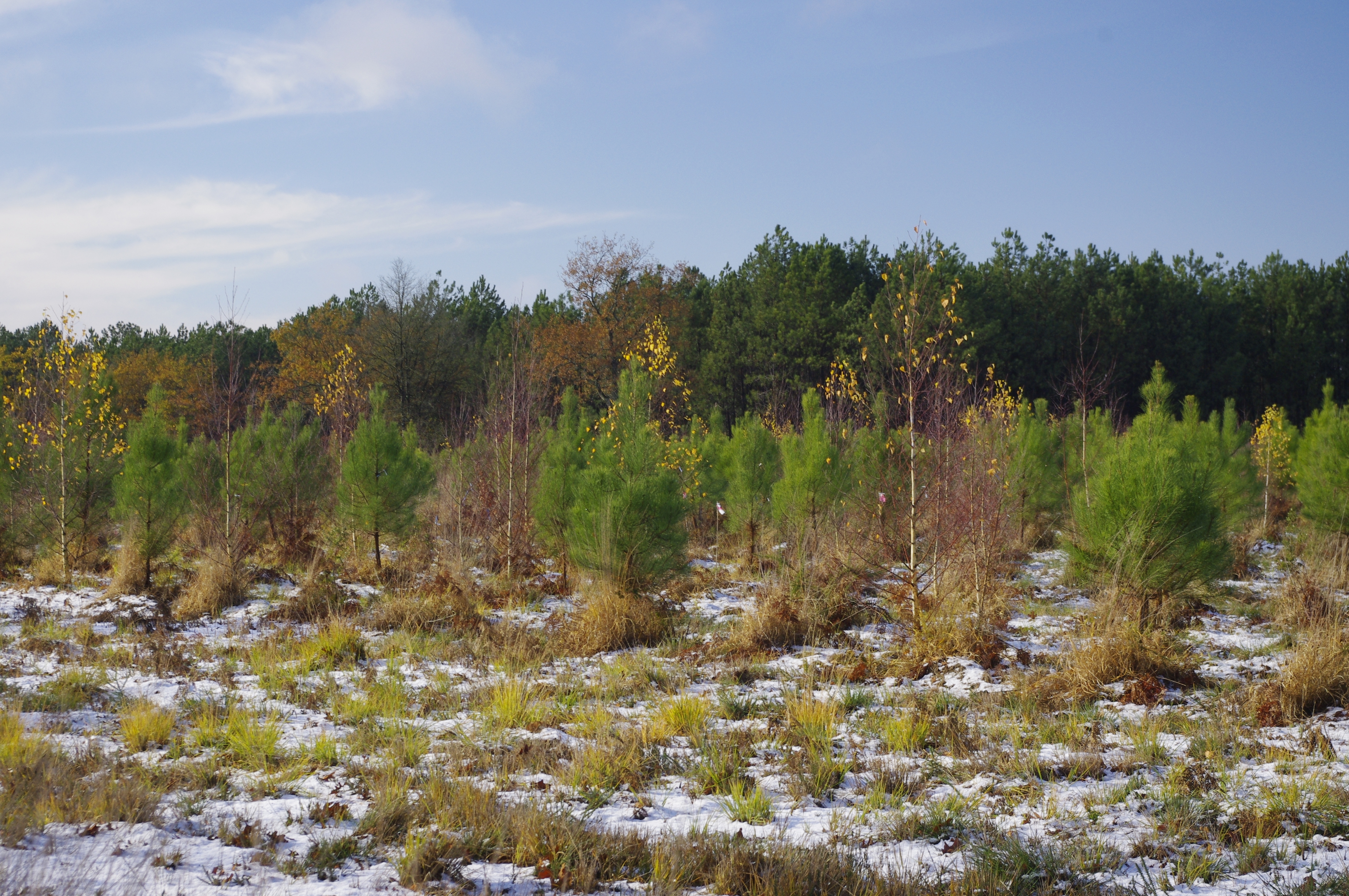 |
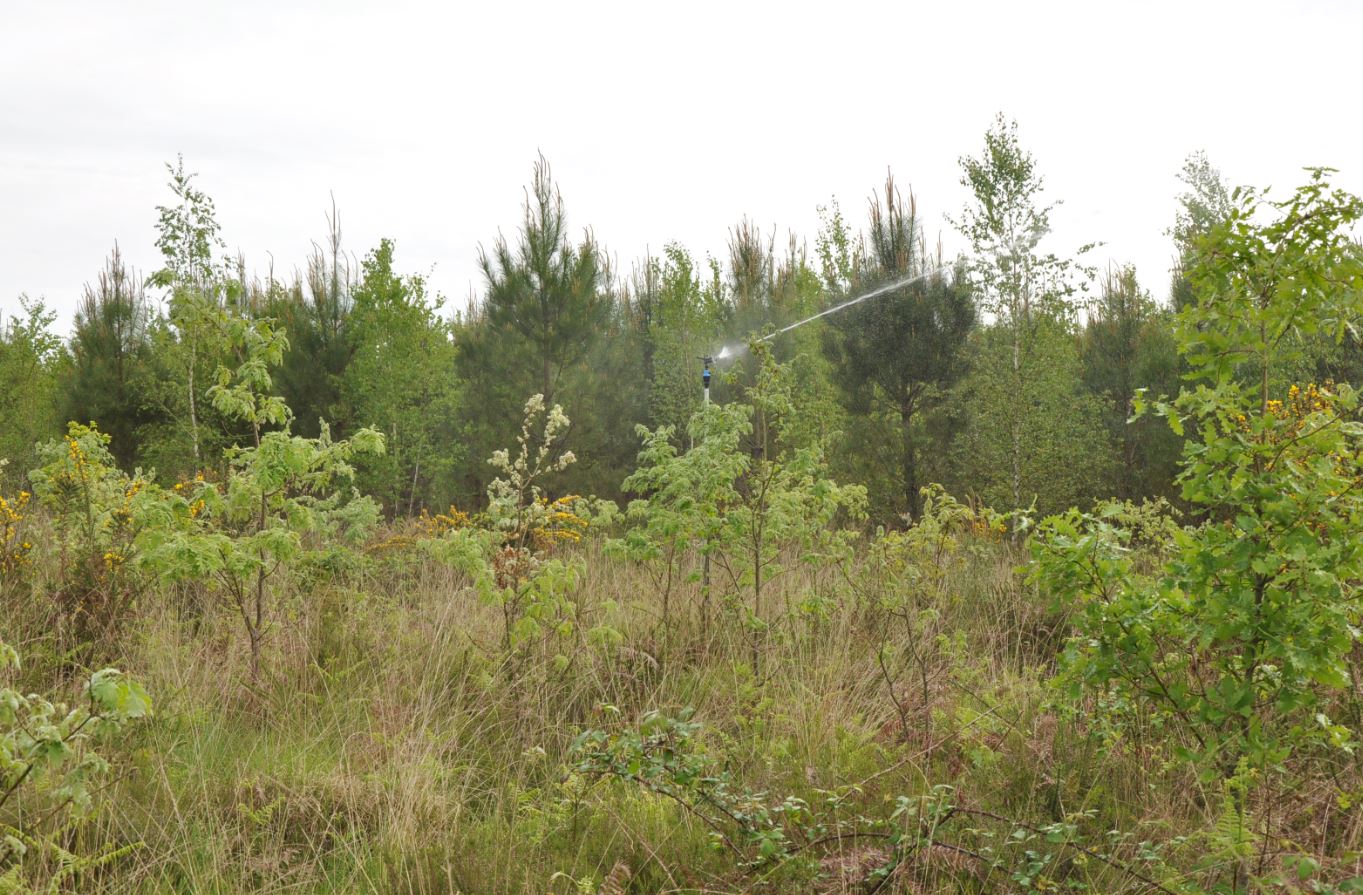 |
| One of the ORPHEE blocks in December 2010 |
The irrigation treatment has started! (May 2015) |






